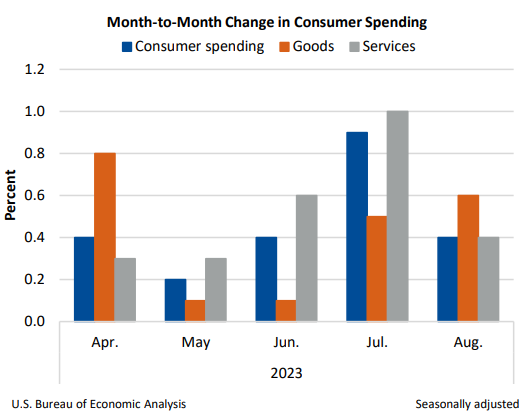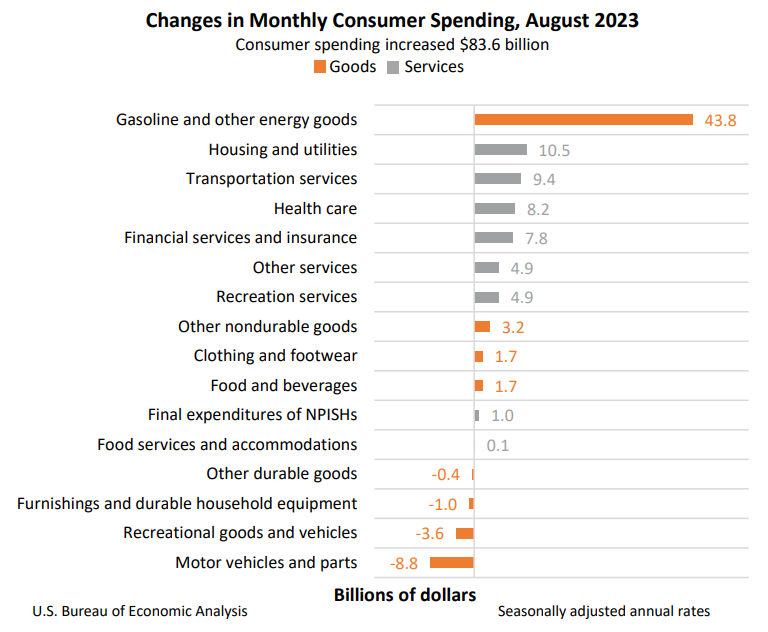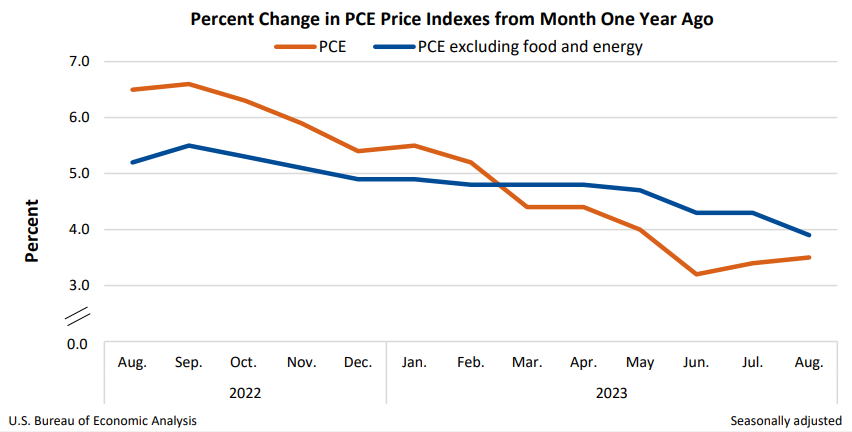Personal income increased $87.6 billion (0.4 percent at a monthly rate) in August. Disposable personal income (DPI)—personal income less personal current taxes— increased $46.6 billion (0.2 percent). Personal outlays—the sum of personal consumption expenditures (PCE), personal interest payments, and personal current transfer payments—increased $86.0 billion (0.4 percent) and consumer spending increased $83.6 billion (0.4 percent). Personal saving was $794.1 billion and the personal saving rate—personal saving as a percentage of disposable personal income—was 3.9 percent in August.
Personal income
In August, personal income increased, primarily reflecting increases in compensation and personal income receipts on assets.
- Within compensation, the increase was led by private wages and salaries, based on data from the Bureau of Labor Statistics’ (BLS) Current Employment Statistics (CES). Services-producing industries increased $41.5 billion and goods-producing industries increased $8.5 billion.
- The increase in personal income receipts on assets was mostly accounted for by personal interest income.
Consumer spending
The $83.6 billion increase in August reflected increases in spending for both services and goods.
- Within services, the largest contributors to the increase were housing and utilities (led by housing); transportation services (led by air transportation), based on Transportation Security Administration data on the number of travelers; and health care (led by hospitals), based on BLS CES and private data.
- Within goods, the largest contributor to the increase was gasoline and other energy goods (led by motor vehicle fuels, lubricants, and fluids), based on Energy Information Administration and BLS data.
PCE price index
From the preceding month, the PCE price index for August increased 0.4 percent. Food prices increased 0.2 percent and energy prices increased 6.1 percent. Excluding food and energy, the PCE price index increased 0.1 percent. For a comparison of PCE prices to BLS consumer price indexes, refer to NIPA Table 9.1U. Reconciliation of Percent Change in the CPI with Percent Change in the PCE Price Index.
From the same month one year ago, the PCE price index for August increased 3.5 percent. Prices for goods increased 0.7 percent and prices for services increased 4.9 percent. Food prices increased 3.1 percent and energy prices decreased 3.6 percent. Excluding food and energy, the PCE price index increased 3.9 percent from one year ago.
Real disposable personal income and consumer spending
Real DPI decreased 0.2 percent in August. Real consumer spending increased 0.1 percent, reflecting an increase in spending on services of 0.2 percent and a decrease in spending on goods of 0.2 percent. Within services, the leading contributors to the increase were transportation services (led by air transportation) and health care (led by hospitals). Within goods, the largest contributor to the decrease was motor vehicles and parts (led by new light trucks).
Comprehensive Update of the National Economic Accounts
Today’s release presents results from the comprehensive update of the National Economic Accounts. The revisions for income estimates begin with January 1979 and revisions for consumer spending begin with January 2013. Monthly estimates for January through March of 2023 include revisions resulting from the incorporation of first-quarter wage and salary data from the Bureau of Labor Statistics (BLS) Quarterly Census of Employment and Wages program. Estimates for April through July of 2023 have been updated to reflect revised monthly data from the BLS Current Employment Statistics program.
Updated quarterly and annual estimates of personal income and outlays were presented as part of the third release of GDP for the second quarter of 2023 on September 28, 2023.
For more information, read the full release.



